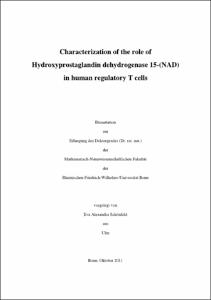Schönfeld, Eva Alexandra: Characterization of the role of Hydroxyprostaglandin dehydrogenase 15-(NAD) in human regulatory T cells. - Bonn, 2012. - Dissertation, Rheinische Friedrich-Wilhelms-Universität Bonn.
Online-Ausgabe in bonndoc: https://nbn-resolving.org/urn:nbn:de:hbz:5n-28840
Online-Ausgabe in bonndoc: https://nbn-resolving.org/urn:nbn:de:hbz:5n-28840
@phdthesis{handle:20.500.11811/5321,
urn: https://nbn-resolving.org/urn:nbn:de:hbz:5n-28840,
author = {{Eva Alexandra Schönfeld}},
title = {Characterization of the role of Hydroxyprostaglandin dehydrogenase 15-(NAD) in human regulatory T cells},
school = {Rheinische Friedrich-Wilhelms-Universität Bonn},
year = 2012,
month = jun,
note = {The focus of the present study was the characterization of the hydroxyprostaglandin dehydrogenase 15-(NAD) (HPGD) in CD4+CD25+ regulatory T cells (Treg) concerning its regulation and role for the development and suppressive function of Treg cells. On the one hand, HPGD fulfills an important function in the metabolism of prostaglandins and is one of the major prostaglandin E2 (PGE2)-metabolizing enzymes. On the other hand, HPGD was reported to be a tumor suppressor. As enhanced numbers of Treg cells can be found in tumor tissue and PGE2 was shown to activate Treg cells and contributes to carcinogenesis, the expression of HPGD in Treg cells is of particular interest.
HPGD expression was shown to be significantly higher expressed in human Treg cells compared to CD4+CD25- T cells (Tconv). Notably, HPGD expression was specific for naturally occurring Treg cells (nTreg) as HPGD was not upregulated during CD4+ T cell differentiation and even induced Treg cells (iTreg) do not show an enhanced HPGD expression. Furthermore, exclusively in nTreg cells, HPGD expression could be specifically modulated by different extracellular stimuli. Even minuscule amounts of IL-2 were sufficient to strongly upregulate HPGD expression. These data further support that HPGD belongs to the nTreg cell specific gene repertoire as low IL-2 receptor signaling also supports thymic development of Treg cells. Thus HPGD might represent a novel nTreg cell molecule that can be used to distinguish them from iTreg cells. Besides that, the dependency of HPGD expression on the extracellular microenvironment also indicates a tissue-specific expression and potential function of HPGD in the Treg cell.
Taken together, the present study demonstrates that HPGD represents a novel gene, which is specific for human naturally occurring Treg cells. Although the relevance of HPGD for the Treg cell function remains to be elucidated, the present study indicates a tissue-specific role of HPGD in Treg cells and provides a basis for further research, to determine the role of Treg cells in the tumor microenvironment.},
url = {https://hdl.handle.net/20.500.11811/5321}
}
urn: https://nbn-resolving.org/urn:nbn:de:hbz:5n-28840,
author = {{Eva Alexandra Schönfeld}},
title = {Characterization of the role of Hydroxyprostaglandin dehydrogenase 15-(NAD) in human regulatory T cells},
school = {Rheinische Friedrich-Wilhelms-Universität Bonn},
year = 2012,
month = jun,
note = {The focus of the present study was the characterization of the hydroxyprostaglandin dehydrogenase 15-(NAD) (HPGD) in CD4+CD25+ regulatory T cells (Treg) concerning its regulation and role for the development and suppressive function of Treg cells. On the one hand, HPGD fulfills an important function in the metabolism of prostaglandins and is one of the major prostaglandin E2 (PGE2)-metabolizing enzymes. On the other hand, HPGD was reported to be a tumor suppressor. As enhanced numbers of Treg cells can be found in tumor tissue and PGE2 was shown to activate Treg cells and contributes to carcinogenesis, the expression of HPGD in Treg cells is of particular interest.
HPGD expression was shown to be significantly higher expressed in human Treg cells compared to CD4+CD25- T cells (Tconv). Notably, HPGD expression was specific for naturally occurring Treg cells (nTreg) as HPGD was not upregulated during CD4+ T cell differentiation and even induced Treg cells (iTreg) do not show an enhanced HPGD expression. Furthermore, exclusively in nTreg cells, HPGD expression could be specifically modulated by different extracellular stimuli. Even minuscule amounts of IL-2 were sufficient to strongly upregulate HPGD expression. These data further support that HPGD belongs to the nTreg cell specific gene repertoire as low IL-2 receptor signaling also supports thymic development of Treg cells. Thus HPGD might represent a novel nTreg cell molecule that can be used to distinguish them from iTreg cells. Besides that, the dependency of HPGD expression on the extracellular microenvironment also indicates a tissue-specific expression and potential function of HPGD in the Treg cell.
Taken together, the present study demonstrates that HPGD represents a novel gene, which is specific for human naturally occurring Treg cells. Although the relevance of HPGD for the Treg cell function remains to be elucidated, the present study indicates a tissue-specific role of HPGD in Treg cells and provides a basis for further research, to determine the role of Treg cells in the tumor microenvironment.},
url = {https://hdl.handle.net/20.500.11811/5321}
}






